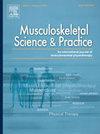鲜为人知的患者报告的上颈椎症状-范围审查
IF 2.2
3区 医学
Q1 REHABILITATION
引用次数: 0
摘要
目的本综述的目的是:(1)描述患者报告的症状,(2)确定鲜为人知的上颈椎疾病患者这些症状发展的潜在机制,为潜在的神经肌肉骨骼管理提供信息。方法使用预定义的术语检索spubmed, Cinahl, Embase, Cochrane, Scopus和Web of Science数据库。本综述包括随机对照试验、观察性研究和病例研究。两位审稿人独立筛选标题、摘要和全文,并将数据提取到图表中。结果对66项研究的99例病例进行回顾性分析。将患者报告的症状分为16个特定部位。虽然头部和颈部疼痛是最常见的,但还发现了其他14种症状。大多数症状似乎与中枢神经系统结构有关(79%),主要是下颅神经和脊髓。其余21%的患者症状似乎主要与茎突和C2脊神经周围的神经血管结构有关,受上颈椎关节变化的影响。结论:本综述的发现将教育临床医生广泛的潜在诊断,并帮助他们了解患者报告的与上颈椎相关的所有症状,从而改进实践。这一信息强调了临床医生询问通常与肌肉骨骼问题无关的非典型症状的重要性。本文章由计算机程序翻译,如有差异,请以英文原文为准。
Lesser-known patient-reported symptoms arising from the upper cervical spine – A scoping review
Objective
The aims of this scoping review were to (1) describe patient-reported symptoms and (2) identify the potential mechanisms for the development of these symptoms in people with lesser-known upper cervical spine disorders to inform potential neuro-musculoskeletal management
Methods
PubMed, Cinahl, Embase, Cochrane, Scopus and Web of Science databases were searched using predefined terms. Randomised control trials, observational studies and case studies were included in this review. Two reviewers independently screened titles, abstracts and full texts, and data was extracted into a charting table. Descriptive statistics were performed
Results
Ninety-nine cases from 66 studies were reviewed. Patient-reported symptoms were grouped into 16 location-specific sites. Although head and neck pain were most common, 14 other symptom groups were identified. Most symptoms appeared to be related to central nervous system structures (79 %), primarily lower cranial nerves and spinal cord. The remaining 21 % of patient symptoms appeared primarily to be related to the neurovascular structures around the styloid process and the C2 spinal nerve, impacted by changes in the upper cervical joints
Conclusions
The findings of this review will educate clinicians about a wide range of potential diagnoses and help them to comprehend the full spectrum of patient-reported symptoms associated with the upper cervical spine, thus improving practice. This information underscores the importance of clinicians inquiring about atypical symptoms not usually associated with musculoskeletal issues.
求助全文
通过发布文献求助,成功后即可免费获取论文全文。
去求助
来源期刊

Musculoskeletal Science and Practice
Health Professions-Physical Therapy, Sports Therapy and Rehabilitation
CiteScore
4.10
自引率
8.70%
发文量
152
审稿时长
48 days
期刊介绍:
Musculoskeletal Science & Practice, international journal of musculoskeletal physiotherapy, is a peer-reviewed international journal (previously Manual Therapy), publishing high quality original research, review and Masterclass articles that contribute to improving the clinical understanding of appropriate care processes for musculoskeletal disorders. The journal publishes articles that influence or add to the body of evidence on diagnostic and therapeutic processes, patient centered care, guidelines for musculoskeletal therapeutics and theoretical models that support developments in assessment, diagnosis, clinical reasoning and interventions.
 求助内容:
求助内容: 应助结果提醒方式:
应助结果提醒方式:


